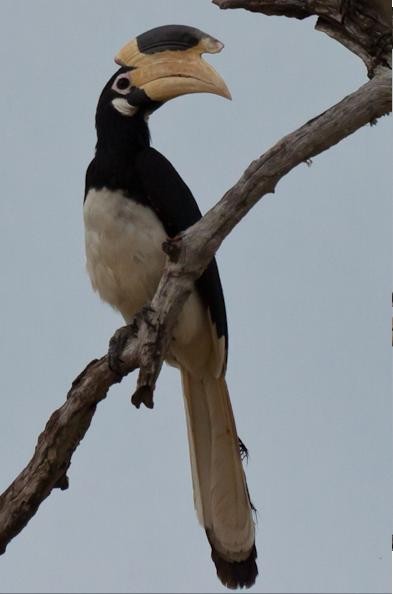Malabar Pied Hornbill
A species of Asian Pied Hornbills and Allies Scientific name : Anthracoceros coronatus Genus : Asian Pied Hornbills and Allies
Malabar Pied Hornbill, A species of Asian Pied Hornbills and Allies
Botanical name: Anthracoceros coronatus
Genus: Asian Pied Hornbills and Allies
Content
Description General Info
 Photo By Berichard , used under CC-BY-SA-2.0 /Cropped and compressed from original
Photo By Berichard , used under CC-BY-SA-2.0 /Cropped and compressed from original Description
The Malabar pied hornbill (Anthracoceros coronatus), also known as lesser pied hornbill, is a bird in the hornbill family, a family of tropical near-passerine birds found in the Old World. Taxonomy The Malabar pied hornbill was described by the French polymath Georges-Louis Leclerc, Comte de Buffon in 1780 in his Histoire Naturelle des Oiseaux. The bird was also illustrated in a hand-coloured plate engraved by François-Nicolas Martinet in the Planches Enluminées D'Histoire Naturelle which was produced under the supervision of Edme-Louis Daubenton to accompany Buffon's text. Neither the plate caption nor Buffon's description included a scientific name but in 1783 the Dutch naturalist Pieter Boddaert coined the binomial name Buceros coronatus in his catalogue of the Planches Enluminées. The Malabar pied hornbill is now placed in the genus Anthracoceros that was introduced by the German naturalist Ludwig Reichenbach in 1849. The species is monotypic. The generic name combines the Ancient Greek anthrax, meaning "coal black" and kerōs, meaning "horn". The specific epithet coronatus is Latin for "crowned". Description The Malabar pied hornbill is a large hornbill, at 65 cm (26 in) in length. It has mainly black plumage, apart from its white belly, throat patch, tail sides and trailing edge to the wings. The bill is yellow with a large, mainly black casque. Females have white orbital skin, which the males lack. Juveniles have no casque. It might be confused with the oriental pied hornbill. Distribution and habitat The Malabar pied hornbill is a common resident breeder in India and Sri Lanka. Its habitat is evergreen and moist deciduous forests, often near human settlements. Nature and behaviour 
Size
65 cm
Life Expectancy
12 years
Nest Placement
Cavity
Feeding Habits
Malabar Pied Hornbill consumes a variety of foods, primarily figs, which constitute up to 75% of its diet during breeding season. Malabar Pied Hornbill also eats small animals and toxic fruits, swallowing prey whole. Their feeding behavior includes foraging for figs year-round, with a notable preference for these fruits.
Habitat
Malabar Pied Hornbill typically inhabits evergreen and moist deciduous forests. It shows a preference for areas with dense tree cover in tropical and subtropical broadleaf forests, often occupying hilly regions. Malabar Pied Hornbill can also be found along the margins of forests and in large woodland plantations. While primarily reliant on forest ecosystems, malabar Pied Hornbill occasionally ventures into nearby fruiting trees in more open areas and cultivated landscapes. This species has adapted to live in proximity to human settlements, which may provide additional foraging opportunities.
Dite type
Omnivorous
General Info
Feeding Habits
Bird food type
Distribution Area
The Malabar pied hornbill is a common resident breeder in India and Sri Lanka. Its habitat is evergreen and moist deciduous forests, often near human settlements. Nature and behaviour 
Species Status
Not globally threatened.